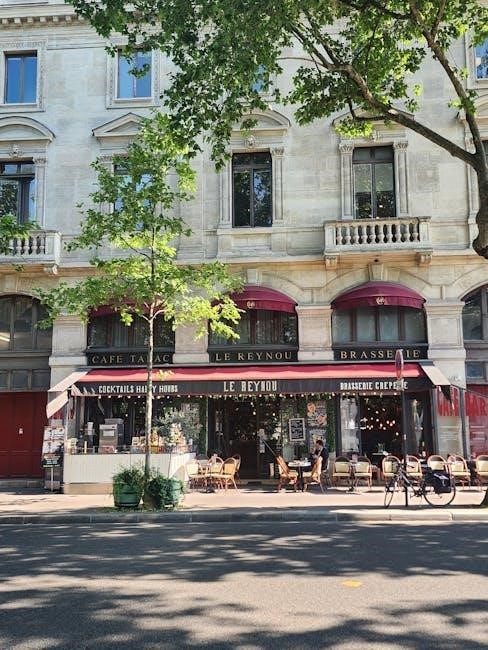A French seam is a popular finishing technique in sewing, known for its elegance and durability․ It encloses raw fabric edges within two rows of stitching, creating a clean, professional finish․ Ideal for lightweight fabrics like silk and chiffon, French seams are commonly used in lingerie, designer dresses, and delicate home furnishing projects․ This method ensures a neat and polished appearance, making it a versatile choice for both garments and home decor․
What is a French Seam?
A French seam is a sewing technique that encloses raw fabric edges within the seam, creating a clean and professional finish․ It involves sewing two lines of stitches: the first with the fabric’s wrong sides together, and the second with the right sides together․ This method ensures that no raw edges are visible on the finished garment or project․ The French seam is particularly effective for lightweight or sheer fabrics, as it prevents fraying and adds durability․ It is often used in high-end garments, lingerie, and home furnishings, providing a polished and elegant appearance․ This technique is ideal for sewists seeking a refined and professional-looking seam․
Why Use a French Seam?
The French seam is favored for its ability to create a clean, professional finish by enclosing raw fabric edges․ It is particularly useful for lightweight or sheer fabrics, such as silk, chiffon, and organza, as it prevents fraying and adds durability․ This technique is ideal for garments where a polished look is essential, like lingerie, evening wear, and delicate home furnishings․ The double stitching process not only strengthens the seam but also ensures a neat appearance from both the inside and outside of the fabric․ Additionally, French seams are less bulky than other finishing methods, making them suitable for intricate designs and curved seams․ They are a timeless choice for sewists aiming to achieve a high-quality, elegant finish in their projects․
Best Fabrics for French Seams
French seams are best suited for lightweight, sheer, or delicate fabrics such as chiffon, silk, organza, and voile․ These fabrics benefit most from the enclosed seam construction, as it prevents fraying and adds durability without bulk․ The technique is particularly effective for materials that are prone to unraveling or where a clean finish is essential, such as lingerie, evening wear, or delicate home furnishings․ Heavier fabrics, like thick cotton or denim, are less ideal due to their weight and stiffness, which can make the seam bulky․ Lightweight fabrics, however, showcase the elegance and precision of French seams, making them a perfect choice for projects requiring a polished appearance․
Tools and Materials Needed
A sewing machine, sharp scissors, straight pins, and an iron are essential․ Use a seam allowance guide and tailor’s chalk for precision․ Fabric shears or pinking shears are optional․
Sewing Machine Setup
Set your sewing machine to a straight stitch for French seams․ Use a shorter stitch length for strength and precision․ Ensure proper thread tension to prevent puckering․ Install a 1/4-inch presser foot to maintain consistent seam allowances․ Use matching thread color for a professional finish․ Preheat your iron for pressing seams flat after sewing․

Necessary Notions: Pins, Scissors, Iron
Pins are essential for aligning fabric accurately before sewing․ Use sharp scissors or pinking shears to trim seam allowances neatly, especially for delicate fabrics․ An iron is crucial for pressing seams flat, ensuring a professional finish․ Use a ironing board to press seams open after sewing and before folding fabric for the second seam․ Ensure your iron is set to the correct temperature for the fabric type to avoid damage․ Sharp tools and proper pressing ensure clean, polished French seams․ These notions are fundamental for achieving the desired elegance and durability in your projects․ They help maintain precision and prevent fraying, making the process efficient and the results flawless․ Proper use of these tools elevates the quality of your French seams․
Seam Allowance Guide
A French seam typically requires a total seam allowance of 5/8 inch (16 mm), with the first seam sewn at 1/4 inch (6 mm) and the second at 3/8 inch (10 mm)․ This ensures raw edges are fully enclosed․ Use a seam allowance guide or presser foot to maintain consistency․ For delicate fabrics, consider increasing the first seam allowance slightly․ Always verify your pattern’s specified seam allowance to avoid sizing issues․ Proper measurement is key to achieving a clean, professional finish․ Adjustments may be needed for bulky or curved seams․ Ensure accuracy to prevent excess fabric waste while maintaining the seam’s neat appearance․ This guide helps you master the technique with precision․

Step-by-Step Guide to Sewing a French Seam
Learn to sew a French seam with this step-by-step guide․ Start by sewing fabric wrong sides together, then trim and press․ Fold right sides together and sew again to enclose raw edges, achieving a clean, professional finish․

Step 1: Pinning the Fabric Wrong Sides Together
Begin by placing the fabric pieces wrong sides together, aligning the edges carefully․ Insert pins perpendicular to the seam line to secure the fabric, ensuring it doesn’t shift while sewing․ This step is crucial as it sets the foundation for a smooth, even seam․ Make sure pins are evenly spaced and removed as you sew to avoid damaging the fabric or breaking the needle․ Proper pinning ensures accuracy and prevents misalignment, especially important for delicate or slippery fabrics like silk or chiffon․ This initial setup guarantees a professional finish in your French seam project․
Step 2: Sewing the First Seam

With the fabric pinned wrong sides together, sew along the edge using a 1/4-inch seam allowance․ Use a straight stitch on your sewing machine, ensuring the stitch length is appropriate for your fabric type․ Keep the fabric steady and guide it smoothly through the machine, maintaining consistent alignment․ A seam guide or 1/4-inch presser foot can help keep the allowance accurate․ As you sew, remove pins carefully to avoid damaging the fabric or breaking the needle․ This first seam creates a secure bond while enclosing the raw edges temporarily․ Once complete, the fabric will have a subtle stitching line on the outside, ready for the next step in creating the French seam․
Step 3: Trimming the Seam Allowance

After sewing the first seam, carefully trim the seam allowance to approximately 1/8 inch․ Use sharp scissors or pinking shears to reduce bulk and prevent excessive fraying, especially on delicate fabrics․ Ensure the trim is even and close to the stitching line without cutting into it․ This step is crucial as it prepares the seam for the second, enclosing stitch․ Trimming neatly ensures the raw edges will be fully enclosed in the final French seam, creating a professional and polished finish․ Keep the fabric flat during trimming to maintain accuracy and avoid uneven edges․ This step sets the stage for the final seam, ensuring a clean and durable result․
Step 4: Pressing the Seam
Open the fabric and press the first seam flat from both the right and wrong sides using an iron set to the appropriate temperature for your fabric․ This ensures the seam lies flat and prepares it for the next step․ Fold the fabric so the right sides are together, aligning the edges carefully․ Press along the seam line again to create a crisp crease, which helps guide the second stitch․ Be careful not to use excessive heat or steam, as this could damage delicate fabrics․ A well-pressed seam ensures a professional finish and makes sewing the second seam easier․ This step is essential for achieving a smooth, enclosed French seam․ Always test your iron temperature on a scrap of fabric first to avoid scorching․ Proper pressing ensures the seam will be straight and neat when completed․
Step 5: Sewing the Second Seam

With the fabric folded so the right sides are together, sew along the pressed seam line using a 3/8-inch seam allowance․ This step encloses the raw edges of the first seam within the second seam, creating a clean, professional finish․ Ensure the edges are aligned carefully and the seam allowance remains consistent․ As you sew, remove pins as you approach them to avoid breaking the needle․ Once complete, backstitch at the beginning and end of the seam for reinforcement․ This final seam traps the frayed edges, resulting in a strong, invisible seam․ The French seam is now complete, providing a durable and elegant finish to your project․
Step 6: Final Pressing
After sewing the second seam, press the entire seam to one side using a hot iron․ Ensure the seam lies flat and smooth, with no puckering or distortion․ Press on both the right and wrong sides of the fabric to achieve a crisp, professional finish․ Use steam if appropriate for your fabric type to help set the seam․ This final pressing step ensures the French seam is nearly invisible and adds a polished touch to your project․ Proper pressing is essential for a clean, elegant appearance, making the seam lie flat and blend seamlessly into the fabric․ This completes the French seam process, leaving a strong and beautiful finish․
Tips for Sewing French Seams
Use sharp scissors, maintain consistent seam allowances, and press thoroughly․ A walking foot aids smooth stitching․ Avoid backstitching for a neat finish․ Patience ensures professional results․
Working with Curves and Darts
When sewing French seams on curved edges or darts, precision is key․ Clip the seam allowance at regular intervals to prevent bulk and ensure smooth curves․ For darts, sew them first before constructing the French seam to maintain a flat finish․ Use plenty of pins to align fabric edges, especially around curves, to avoid misalignment․ A smaller seam allowance, such as 1/4 inch, works well for intricate shapes․ After sewing, trim excess fabric carefully and press thoroughly to eliminate puckering․ This technique ensures a professional look on garments like lingerie or dresses with curved details․ Patience and careful handling yield flawless results․
Avoiding Common Mistakes
To ensure a flawless French seam, avoid common pitfalls․ Properly align fabric edges before sewing to prevent mismatched seams․ Maintain consistent seam allowances during both stitching steps to avoid unevenness․ Use sharp scissors or pinking shears for trimming to minimize fraying․ Press thoroughly after each step to eliminate puckering and ensure a smooth finish․ Avoid sewing over pins, as this can damage your machine or distort the fabric․ Keep the fabric steady during stitching to prevent stretching or misalignment․ By addressing these issues, you can achieve a professional, polished result with French seams․

Where to Use French Seams
French seams are perfect for lingerie, lightweight fabrics, and delicate home furnishing projects․ They add elegance and durability to garments like dresses and sheer curtains, ensuring a polished finish․
Garments: Lingerie, Dresses, and More
French seams are ideal for delicate garments like lingerie, where a clean finish is essential․ They are also perfect for lightweight dresses, blouses, and sheer fabrics, ensuring a polished look․ The technique minimizes fraying and adds durability, making it suitable for intricate designs and high-end fashion․ Additionally, French seams can be used in undergarments and sleepwear, where comfort and neatness are key․ This method is particularly favored by couture designers for its ability to enhance both the appearance and longevity of garments, making it a versatile choice for various sewing projects;
Home Furnishing Projects

French seams are a great choice for home furnishing projects, adding a professional finish to items like table linens, curtains, and pillowcases․ The technique is especially useful for lightweight fabrics, such as silk or chiffon, ensuring a clean and elegant appearance․ It minimizes fraying, making it ideal for decorative items that require durability․ French seams can also be used on delicate fabric projects, such as lace tablecloths or sheer drapes, where a neat finish is essential․ This method enhances the overall look of home decor, providing a polished and sophisticated result․ It’s a versatile technique that works beautifully for both functional and decorative home sewing projects․

Mastering French seams enhances your sewing skills, offering a clean, professional finish․ Ideal for delicate fabrics and various projects, this technique ensures durability and elegance in every stitch․
Final Thoughts on Mastering French Seams
Mastering French seams is a rewarding skill that elevates your sewing projects to a professional level․ This technique not only ensures a clean, polished finish but also adds durability to your creations․ Whether you’re crafting delicate lingerie, elegant dresses, or intricate home furnishings, French seams offer a refined touch․ With practice, you’ll find it becomes second nature, allowing you to tackle even complex patterns with confidence․ Remember, patience and attention to detail are key to achieving perfect results․ Once mastered, French seams will become a go-to technique in your sewing arsenal, helping you create beautiful, long-lasting garments and projects․

Leave a Reply
You must be logged in to post a comment.